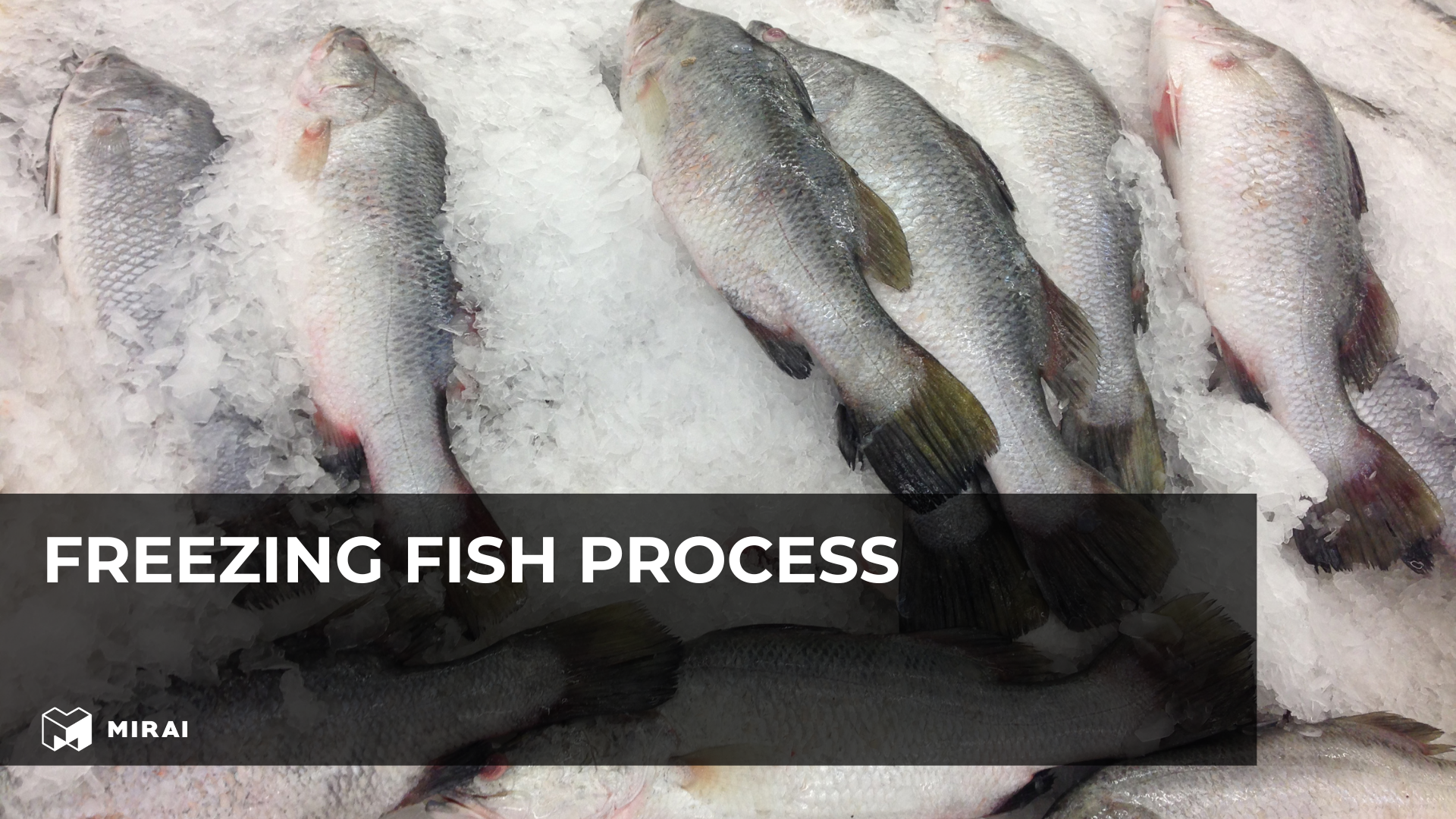Freezing fish process

Fish freezing is a widely used method for preserving the freshness and quality of fish. This process allows for long-term storage and transportation of fish, ensuring it remains safe and suitable for consumption. In this article, we will explore the purposes of freezing fish, the principles behind it, various methods, Mirai products used in the freezing process, factors affecting the quality of frozen fish, and the best defrosting methods.
Introduction
Freezing fish is a crucial technique in the seafood industry and home kitchens alike. It extends the shelf life of fish, prevents spoilage, and maintains nutritional value. Understanding the best way to freeze fish and the factors that affect its quality is essential for ensuring that the fish remains tasty and safe to eat even after extended storage periods.
Purposes of Freezing Fish
The primary purposes of freezing fish include:
- Preservation: Freezing fresh fish helps preserve its texture, flavor, and nutritional content by slowing down the growth of bacteria and enzymes that cause spoilage.
- Convenience: Frozen fish can be stored for longer periods, providing convenience for consumers who can enjoy fresh-tasting fish even when it's out of season.
- Transportation: Freezing fish allows for transportation over long distances without compromising quality, making it possible for people worldwide to enjoy a variety of fish species.
- Economic Benefits: For both producers and consumers, freezing fish reduces waste and economic losses due to spoilage.
Principles of Freezing Fish
Freezing fish involves lowering the temperature to a point where microbial and enzymatic activities are significantly slowed down. This process prevents spoilage and maintains the fish's quality. However, the process must be carefully managed to avoid damage to the fish's cellular structure, which can affect texture and taste.
Pros and Cons
Pros
- Extended Shelf Life: Properly frozen fish can last several months without significant loss of quality.
- Nutrient Retention: Freezing preserves the nutritional value of fish.
- Safety: Freezing kills parasites and slows down bacterial growth, making the fish safe to eat.
- Convenience: Frozen fish is easy to store and use at a later time.
Cons
- Texture Changes: Improper freezing can lead to changes in texture, making the fish mushy or dry when thawed.
- Freezer Burn: Poor packaging can result in freezer burn, which affects the taste and quality of the fish.
- Energy Consumption: Freezing requires energy, which can be costly and environmentally impactful.
Methods
Various methods can be employed to freeze fish, each with its own advantages:
- Blast Freezing: This method involves rapidly freezing fish at extremely low temperatures (-40°C or lower) using high-speed air circulation. It is one of the best ways to preserve the quality of fish.
- Plate Freezing: Fish are placed between metal plates that conduct cold temperatures quickly, ensuring even and rapid freezing.
- Immersion Freezing: Freezing fish in water or brine is effective for fish with high water content, as it prevents dehydration and freezer burn.
- Cryogenic Freezing: This involves using liquid nitrogen or carbon dioxide to freeze fish instantly, maintaining high quality and freshness.
Mirai Products Used In The Process Of Freezing Fish
Mirai Intex machines are advanced refrigeration systems for creating and maintaining ultra-low temperatures, making them ideal for use in the fish industry. In this chapter, we will look at how these machines can be used for fish freezing and long-term storage, and discuss the benefits of ultra-low temperatures for preserving product quality.
Principles of operation of Mirai Intex machines
Mirai Intex machines utilize unique technologies to achieve and maintain temperatures well below freezing, which is especially important when freezing fish. They are able to create conditions where temperatures can drop to -60 °C and below. This temperature regime is important for rapid freezing of fish, which prevents the formation of large ice crystals inside the cells, preserving the texture and nutritional properties of the fish.
Ultra-low temperature fish storage
In addition to freezing, Mirai Intex machines can be used effectively for long-term fish storage. Storage chambers equipped with these machines maintain temperatures between -30 °C and -60 °C. This temperature regime slows or stops most biochemical processes, including fat oxidation and protein degradation, which keeps fish fresh and safe for consumption for a long time.
Storing fish at ultra-low temperatures has several advantages:
- Extended shelf life: Fish can be stored for months without loss of quality.
- Preservation of taste and nutritional properties: Low temperatures prevent loss of aroma, flavor and vitamins.
- Product safety: Low temperatures prevent the growth of microorganisms, which ensures product safety.
Applications in industry and fishing boats
Mirai Intex machines are possible to be used also on fishing vessels. Their compactness and efficiency allow them to be installed on vessels, allowing fish to be frozen immediately after catching. This is particularly important for preserving fish quality, as freshly caught fish is frozen immediately, preserving its properties.
Economic efficiency and environmental friendliness
The use of Mirai Intex machines is cost-effective as they consume less energy than traditional freezing systems. This is achieved through the use of advanced heat transfer and insulation technologies. In addition, the use of ultra-low temperatures reduces product loss, which also contributes to savings.
Environmentally, Mirai Intex machines ensure sustainable use of resources through efficient energy consumption and reduced carbon dioxide emissions. In addition, MIRAI machines use air as a refrigerant, which is a very important aspect in terms of freezing products and keeping them free of harmful substances.
Factors Affecting the Quality of Frozen Fish
Several factors influence the quality of frozen fish:
- Freshness: Freezing fish immediately after catching ensures the best quality. Delays can lead to spoilage and degradation.
- Handling: Proper cleaning and handling before freezing are crucial. Fish should be gutted, cleaned, and prepared correctly to avoid contamination.
- Freezing Rate: Rapid freezing prevents the formation of large ice crystals that can damage the fish's cellular structure.
- Packaging: Air-tight and moisture-proof packaging prevents freezer burn and preserves quality.
- Storage Temperature: Consistently low temperatures (-18°C or lower) are essential to maintain the quality of frozen fish.
Defrosting Methods
Proper defrosting is as important as freezing to maintain the quality of fish. Here are some effective defrosting methods:
- Refrigerator Thawing: This is the safest and best way to thaw fish. Place the fish in the refrigerator for several hours or overnight, allowing it to thaw slowly and evenly.
- Cold Water Thawing: Submerge the fish in cold water, ensuring it is in a leak-proof bag. Change the water every 30 minutes until the fish is thawed.
- Microwave Thawing: While convenient, this method requires careful attention to avoid partial cooking. Use the defrost setting and check frequently.
- Cooking from Frozen: Some fish can be cooked directly from frozen, although this method is best for smaller pieces or fillets.
Conclusion
Freezing fish is a highly effective method for preserving its quality, extending its shelf life, and ensuring safety. By understanding the principles of freezing fish, the best methods to use, and the factors affecting quality, consumers and industry professionals can enjoy high-quality frozen fish year-round. Mirai's advanced freezing products provide innovative solutions for the seafood industry, enhancing efficiency and quality. Proper defrosting techniques ensure that the fish retains its texture and flavor, making frozen fish a convenient and reliable option for consumers worldwide.

